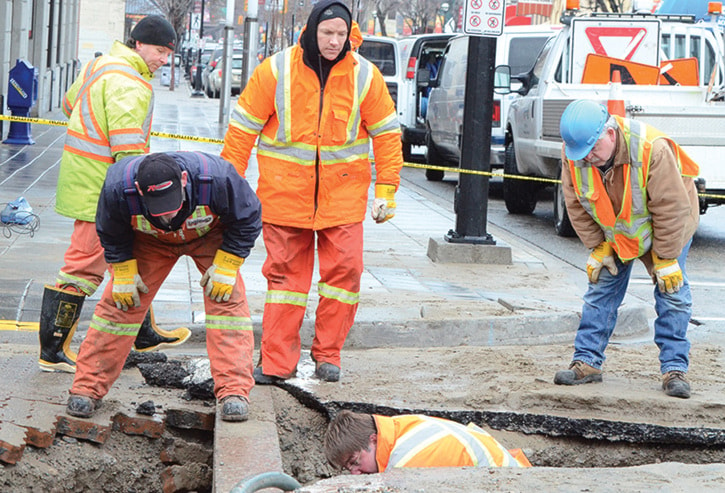Numbers were flying fast in council chambers Tuesday afternoon, especially the $175-million infrastructure deficit the City of Penticton is facing.
“The material contained in this report should not be considered a crisis,” said interim CAO Mitch Moroziuk. “It should be considered a wake-up call.”
There are going to be some tough choices ahead in order to deal with the infrastructure deficit, said Moroziuk, using the 66-year-old Memorial Arena as an example.
(read more:Memorial Arena needs immediate repairs to keep users safe)
“We need to plan for its upgrade or its replacement,” said Moroziuk. The building is well-used and bookings are increasing, but it requires $13.5 million in upgrades to keep operating. Over time, Moroziuk said, the overall lifecycle cost of Memorial Arena would work out to $31.9 million, but the replacement cost would be $16.6 to $17.6 million, working out to a lifecycle cost of $27.7 million for a new building.
In the short term, Moroziuk said, the focus is going to be on the general infrastructure deficit of $77 million, which applies to roads, buildings and parks.
“It is anticipated we will need to generate $8 million per year for the next ten years to do that,” said Moroziuk, explaining the larger goal was to work out ways to bring the required investment down, while increasing infrastructure fund and address the imbalance by 2027.
“Our goal is to have those two lines cross 10 years from now,” said Moroziuk.
Moroziuk said there are a number of factors that helped put Penticton in this fix, starting with a lack of population growth and the matching lack of growth in the tax base; the city’s population is only about 34,000, not much higher than it was in 2002. Another factor is the decline in senior government responsibility. In 1955, federal and provincial governments were responsible for 78 per cent of public facilities, but by 2011, the balance shifted to 52 per cent of the responsibility being borne by municipalities.
A third, key factor is the period from 2011 to 2015 where there were small, and in some cases, negative tax increases.
“If we would have had moderate increases over that period — in the range of three per cent -— our revenue stream would be considerable different than it is today,” said Moroziuk, who noted that Grand Forks brought in a 15 per cent tax increase, 13.7 per cent dedicated to dealing with their asset management problem.
The $175 million represents the value of Penticton’s infrastructure — including roads, parks, facilities, vehicles, water and sewer systems — that has passed its expected length of service, but is still in use.
There is need for significant investment, according to Moroziuk, but it doesn’t all have to come at once.
“Plans we are creating will influence budgets for the next ten years and beyond,” he said.
Taken together, the replacement value of Penticton’s infrastructure assets adds up to about $1.09 billion, which includes 237 km of water pipe, 174 km of sewer pipe, 88 km of storm sewer and 184 km of roads. Much of it is aging, with remaining life of about 63 per cent for the vehicle fleet down to an average of 27 per cent for buildings.
“Not enough attention has been given to the upgrade and replace quadrant of our infrastructure in the past. Our community infrastructure is starting to show its age. We have some assets that are over 100 years old,” said Moroziuk, referring to Leir House. Overall, he said, the city’s assets have an average remaining life of 48 per cent.
“Asset failures are increasing in frequency. One example from February 2015 was the severe water main break at Main St. and Wade Avenue. This affected residents and businesses throughout the downtown core and resulted in a boil water advisory and water disruption for several days,” wrote Moroziuk in his report.
Options for dealing with the infrastructure deficit break down into two categories: increase money flowing into the city coffers by encouraging population growth, lobbying for better access to government grants and increasing taxes. The other side of the coin is reducing costs by selling off unneeded buildings and reducing service levels. For example, Moroziuk said the frequency of street sweeping or snow removal could be reduced.
“Some communities don’t do snow removal in residential areas, they only do it on main thoroughfares,” said Moroziuk.
Ongoing work on Downtown Revitalization, Moroziuk said is not a wasted investment. The majority of the cost went to badly-needed underground infrastructure repairs — of the total $2.21 million cost for the 200-block of Main Street, $1.7 million went to infrastructure and $510,000 for beautification.
“To attract people, you also have to provide them with amenities they are going to find attractive. There is a balance there,” he said.
Councillor Max Picton encouraged the citizens to get involved in the decision-making process through www.shapeyourcitypenticton.ca and other options, which include public consultation sessions on Oct. 11 and 15 and ongoing into November, prior to this year’s budget process.
“When we start talking about a problem of this size … this is going to have a major impact on quite a few citizens,” said Picton.
